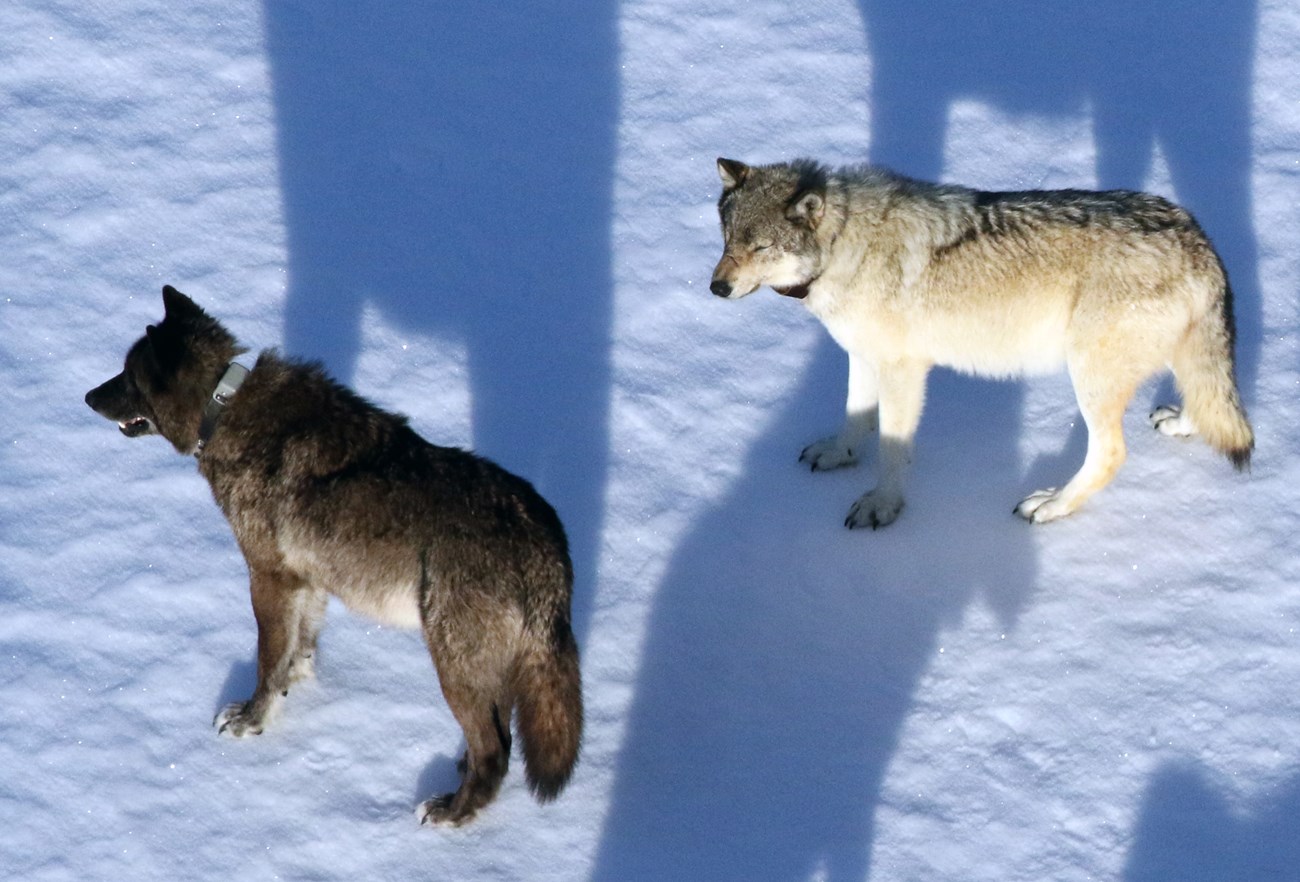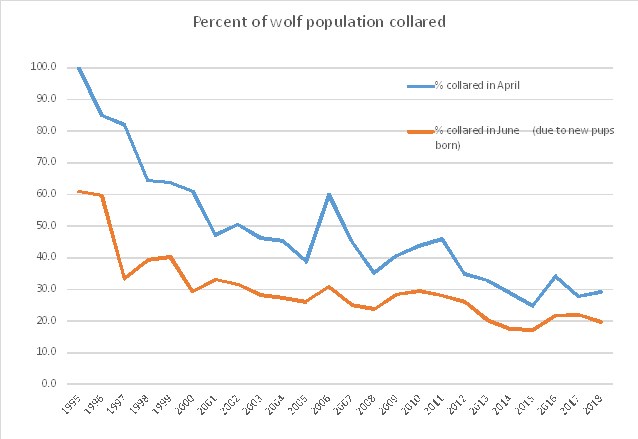Last updated: February 3, 2025
Article
Research Report: Using Radio Collars to Study Yellowstone Wolves

NPS Photo - D. Stahler
by Kira Cassidy
“Can you check the fit of his collar?” Doug Smith, the Yellowstone Wolf Project Leader, asks while a sedated wolf rests its head in his lap. I reach over, away from the second tranquilized wolf in front of me and slide my hand under the collar. The wolf’s fur is thick and warm and for a few seconds my fingers are out of the cold and start to thaw. I tilt my hand but can’t quite turn it all the way—about 3 finger’s width of space is between the wolf’s neck and the collar.
“It seems perfect.” I respond as Doug holds the collar and gently pulls forward.
“It won’t slide off but it’s not too tight. And this adult is done growing.” He starts to attach the locking bracket and nuts, then asks both Biologist Dan Stahler and Biological Technician Erin Stahler to also check the collar’s fit after they’ve finished securing the collar on the third wolf lying between them. Every handler checks and rechecks each collar. Not only does this help eliminate any human error but takes advantage of averaging out individual handler’s tendencies to find that best fit.
Since the reintroduction of gray wolves to Yellowstone National Park in 1995 and 1996, radio collars have been used as the main tool for monitoring and research. Collaring efforts were never intended to be used as tool to locate wolves for public viewing. Now, 24 years, 7 wolf generations, and 616 collars later, radio-collaring remains an important method to collect all kinds of data and has undergone its own technological evolution.
When wolves were first brought to Yellowstone every wolf was radio-collared. At the time the population was fairly small and every wolf was enormously valuable to the success of the reintroduction. Once the wolf population grew and expanded, there wasn’t a strong need to have every individual marked so the Yellowstone Wolf Project decided to cut back on the number of radio-collars deployed (Figure 1). At this stage, the collaring objectives were to maintain telemetry contact with packs not individuals. By the late 2000’s GPS radio-collar technology was becoming more reliable and started to replace the use of the standard VHF (Very High Frequency) collars used for so many years. The battery-life of all types of collars was also improving with some current collars lasting up to seven years. Though more expensive, GPS satellite collars ultimately offer more options for data collection and increasingly rigorous scientific questions can be answered by combining GPS movement information and observational data. Yellowstone National Park is one of the best places in the world to integrate monitoring tools and achieve significant scientific results.
A great deal of care and consideration is taken when deciding how, when, and most-importantly WHY to radio-collar any animal. Collaring of Yellowstone wolves was first mandated under the USFWS’s reintroduction plan to facilitate monitoring of the newly restored wolf population in Rocky Mountains. Annual counts of individuals, packs, and breeding pairs were necessary to meet Endangered Species Act delisting criteria and radio collars were the most effective tool available for this type of large carnivore monitoring. Simultaneous to this collaring mandate, the Wolf Project established long-term ecological studies on the effects of wolf recovery on ecosystem structure and function. Over the last two decades, radio collars have been instrumental to the scientific discovery about wolves. Studies on predator-prey interactions, social dynamics, dispersal, survival, reproduction, and multi-carnivore interactions that have benefited by the use of radio collars have placed Yellowstone wolves in the spotlight of large carnivore science and conservation. Building on this success, radio collar technology will continue to be integrated with other monitoring and analytical tools to keep Yellowstone wolves at the frontier of science discovery. The Wolf Project undergoes detailed and careful examination of all collaring and handling procedures, guided by NPS wildlife veterinarians and professional approved protocols. Scientific data relies on eliminating biases so a radio-collared wolf’s behavior and decisions must accurately reflect its demographic, population, and even its species for the data to be worthwhile. For science’s sake, and for the wolf’s sake, collars cannot cause a wolf any issues—positive or negative.
Fitting radio-collars on wolves is an art form that takes experience and careful attention to each wolf’s well-being. Wolf Project personnel consider the size, sex, and age of each wolf before adjusting a final collar neck size. For example, collaring male pups in their first winter can be the most challenging – it is important to fit these individuals loosely because young males stand to gain the most mass as they climb their growth curve in their first years of life. Additionally, some wolves are naturally thinner, lankier, stockier or more muscular than others; so each collar is fit to the individual. The collars used by the Yellowstone Wolf Project weigh approximately 500 grams (0.5 kg) which amounts to 0.8-1.8% of the wolf’s total body mass in proportion to the collar. This weight is less than 5% of the maximum allowable weight agreed-on by veterinarians for gray wolves based on their body weight, muscle mass, and morphology. Due to this great care and concern for wolf welfare, only three wolves (<1%) have died due to collaring efforts in the last 24 years. This is well below the rate considered acceptable (2-3%) for wildlife handling studies and had our mortality been at that level 12-18 wolves would have died.
Wolves wearing radio-collars do not act any differently than wolves without radio-collars—we have no evidence suggesting collars influence rates of dispersal, mortality, survival, breeding success, and leadership. And the collar does not seem to bother the wearer at all. The Wolf Project has not recorded increased scratching or rubbing for wolves wearing collars; the wolves seem to completely ignore their own collars. A few packs have made collar-chewing a bit of a fun past-time - between 2017-2018 the Cougar Creek pack chewed off three of their six collars. This likely occurs when curious pack mates, probably younger animals who are more prone to chewing on each other in general, key in on the novelty of a collar.
Besides these few exceptions, the collars appear to be completely ignored.
A few wolf packs in Yellowstone have territories in thicker forested areas or more remote areas of the park which makes capture and monitoring difficult. Because these packs are more challenging to maintain radio-collars in, other tools like remote camera traps are used to monitor. This type of data is limited compared to radio-collar data but the information can be used to accurately estimate total wolf numbers and density, pack sizes, and sometimes reproduction in the pack. Noninvasive genetic data can also be collected, primarily from scat and hair left behind on the landscape, and used to identify unique DNA profiles of individuals. Some Yellowstone research has relied on such methods for documenting pack size and reproduction.
Studying a charismatic apex predator of Yellowstone National Park is continually a fascinating, rewarding, and humbling experience. The Wolf Project goals and research constantly adjusts to current technology, National Park Service and veterinarian guidance, and the wolves themselves. Because of the team of people dedicated to the welfare of Yellowstone’s wildlife, radio-collaring remains a safe and effective way to study the mysterious and wild gray wolf. Through the 24 years of wolf research in Yellowstone National Park, many questions have been answered, and more have emerged, about wolf ecology, their societies, =, and vulnerabilities to humans and human-altered changes to ecosystems. The curiosity, and the science, continues.
Learn more about wolf research in Yellowstone National Park.

